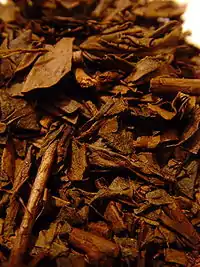Hōjicha
Hōjicha (焙じ茶, ほうじ茶) is a Japanese green tea. It is distinctive from other Japanese green teas because it is roasted in a porcelain pot over charcoal, whereas most Japanese teas are steamed. The tea is fired at a high temperature, altering the leaf color tints from green to reddish brown. The process was first performed in Kyoto, Japan, in the 1920s and its popularity persists today.[1]
| Hōjicha | |
|---|---|
 | |
| Type | Green |
| Other names | hōji-cha, houjicha, pan-fried / oven roasted tea |
| Origin | Japan |
| Quick description | Popular in Japan; roasted bancha or kukicha tea, often used as an after-dinner tea |
| Temperature | 82 °C (180 °F) |
| Time | 30 sec to 3 minutes |

Description
Hōjicha is often made from bancha (番茶, "common tea"),[2] tea from the last harvest of the season; however, other varieties of Hōjicha also exist, including a variety made from sencha, and kukicha, tea made from the twigs of the tea plant rather than the leaves.
Hōjicha infusions have a light- to reddish-brown appearance and are less astringent due to losing catechins during the high-temperature roasting process.[3] The roasted flavors are extracted and dominate this tea: the roasting replaces the vegetative tones of other varieties of Japanese green tea with a toasty, slightly caramel-like flavor. The roasting process used to make Hōjicha also lowers the amount of caffeine in the tea.[4] Because of its mildness, Hōjicha is a popular tea to serve during the evening meal or after, before going to sleep, and even preferred for children and the elderly.
See also
References
- "History of hojicha". Retrieved 2018-06-23.
- Clayton, Liz. "Tea Time: All About Hojicha". serious eats. Retrieved 20 January 2012.
- Kuroda, Yukiaki (2004). Health effects of tea and its catechins. 30: Kluwer Academic. ISBN 0-306-48207-X.CS1 maint: location (link)
- "Components of Hojicha - IPPODO". www.ippodo-tea.co.jp. Retrieved 13 April 2018.